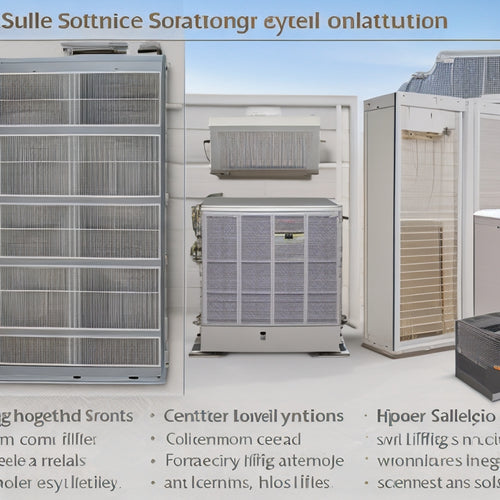What Incentives Are Driving Electric Fleet Adoption?
Share
You're likely considering adopting electric fleets due to the financial, regulatory, and environmental benefits. Rightly so, as a multitude of incentives are driving this shift. Federal tax credits offer up to $175,000 per electric vehicle, while state and local incentives vary, providing rebates and tax credits. Regulatory mandates, like zero-emission vehicle mandates, are also pushing adoption. Additionally, utility incentives, low-carbon fuel standard credits, and carbon credit opportunities make the switch more attractive. You're not alone in exploring this shift; discover how these incentives can work together to drive your fleet's electrification.
Key Takeaways
• Financial incentives, including federal tax credits and state/local rebates, offset higher upfront costs and accelerate ROI.
• Regulatory mandates, like zero-emission vehicle targets, drive EV adoption through stricter government policies.
• Utility incentives, such as discounted rates for charging, optimize energy costs and encourage EV adoption.
• Low-carbon fuel standard credits generate revenue through emission tracking and process optimization.
• Infrastructure support, including private grants and corporate partnerships, accelerates the shift to electric fleets.
Federal Tax Credits for EV Fleets
You can claim a federal tax credit of up to $175,000 per electric vehicle, making it more financially viable to convert your fleet to electric. This incentive is a significant driver of EV adoption, allowing you to recoup a substantial portion of your investment.
By taking advantage of these tax benefits, you can offset the higher upfront costs of electric vehicles and accelerate your return on investment. As you shift your fleet to electric, you'll not only reduce your carbon footprint but also reap the financial rewards of going green.
With federal tax credits, you're in control of your fleet's shift to electric, and the benefits are clear: increased ROI, reduced emissions, and a more sustainable future.
State and Local Incentives Vary
As you explore state and local incentives for electric fleet adoption, you'll find that regional programs can greatly reduce costs.
For instance, some states offer credits for EV charging infrastructure, while others provide rebates for fleet electrification.
Regional Incentive Programs
Regional governments and local authorities are introducing a diverse range of incentives to accelerate the adoption of electric fleets, with varying levels of support depending on the jurisdiction.
As you explore regional incentive programs, you'll find that some areas offer more lucrative benefits than others.
-
Some regions offer rebates for purchasing electric vehicles, reducing the upfront cost of adoption.
-
Others provide tax credits for businesses that invest in electric fleets, offsetting the cost of migration.
-
A few forward-thinking regions even offer preferential parking and toll passes for electric vehicles, making them a more convenient option.
Local Government Credits
Across the United States, over 30 states offer local government credits, providing businesses with a financial boost to electrify their fleets, with credits ranging from $2,500 to $20,000 per vehicle.
You can leverage these credits to offset the higher upfront costs of electric vehicles (EVs) and expedite your fleet's shift. By taking advantage of local government credits, you'll not only reduce your operating expenses but also contribute to a cleaner environment.
Additionally, you'll reap municipal benefits, such as improved air quality and reduced noise pollution, which can enhance community outreach and engagement.
Zero Emission Vehicle Mandates
By 2035, countries like Norway, the UK, and France will have banned the sale of internal combustion engines, driving demand for electric fleets and prompting companies to adapt their operations to comply with zero-emission vehicle mandates.
As a fleet operator, you'll need to prepare for this shift. Governments are implementing policies to improve Air Quality and reduce emissions, and you'll need to stay ahead of the curve.
Here are just a few reasons why zero-emission vehicle mandates are driving electric fleet adoption:
-
Government Policies are getting stricter, with countries setting ambitious targets for electric vehicle adoption
-
Air Quality concerns are pushing cities to adopt cleaner transportation options
-
Public Pressure is mounting, with consumers demanding sustainable practices from companies
Utility Rate Discounts for Charging
As you prepare to convert your fleet to electric vehicles, you can benefit from utility rate discounts for charging, which can greatly reduce your operating costs. By taking advantage of Time of Use (TOU) rates, you can optimize your charging schedule to coincide with off-peak hours, when electricity rates are lower. This strategic approach can lead to significant savings.
| Rate Plan | Peak Hours | Off-Peak Hours |
|---|---|---|
| TOU-1 | 12pm-6pm | 10pm-8am |
| TOU-2 | 2pm-8pm | 10pm-6am |
| TOU-3 | 3pm-9pm | 11pm-7am |
Low-Carbon Fuel Standard Credits
As you explore the benefits of Low-Carbon Fuel Standard Credits, you'll find that generating credits can be a lucrative opportunity.
You'll need to understand the credit generation process, which involves tracking and reporting the amount of low-carbon fuel used by your electric fleet.
Credit Generation Process
You generate Low-Carbon Fuel Standard (LCFS) credits by creating a pathway that accurately measures and reports the lifecycle greenhouse gas emissions of your electric fleet's fueling process. This process requires meticulous attention to detail, as even slight variations can impact credit valuation.
To maximize your credits, focus on process optimization:
- Guarantee accurate metering and monitoring of energy consumption
- Implement a robust data management system to track and analyze emissions data
- Regularly audit and refine your reporting process to minimize errors and maximize credits earned
Revenue Stream Potential
By monetizing your earned LCFS credits, you can access a lucrative revenue stream that boosts your bottom line and speeds up your shift to an electric fleet. This new revenue stream can open up new markets and opportunities for your business.
By leveraging data analytics, you can optimize your credit generation and maximize your returns. With accurate forecasting and tracking, you can make informed decisions to capitalize on this revenue stream.
As the demand for low-carbon fuels continues to grow, you can position your business to capitalize on this trend. By monetizing your LCFS credits, you'll not only reduce your operating costs but also increase your revenue, giving you greater control over your business's financial future.
California's HVIP Program Benefits
California's Hybrid and Zero-Emission Truck and Bus Voucher Incentive Project (HVIP) has been consistently disbursing vouchers to eligible fleets, providing up to $120,000 per vehicle to support the adoption of electric trucks and buses.
You, as a fleet owner, can leverage this program to expedite your shift to electric. By participating in HVIP, you can:
-
Reduce your upfront costs and increase your return on investment
-
Take advantage of California's favorable regulatory environment for electric fleets
-
Join the ranks of successful fleets that have already made the shift to electric, such as logistics and delivery companies
New York's Voucher Incentive Program
New York's Voucher Incentive Program is fueling the electric fleet revolution, offering up to $100,000 per vehicle in vouchers to eligible fleets, making it a lucrative opportunity for you to electrify your operations.
Here's a breakdown of the program's key aspects:
| Category | Description | Details |
|---|---|---|
| Voucher Allocation | Funding for eligible fleets | Up to $100,000 per vehicle |
| Program Evaluation | Measuring program success | Quarterly reports, data analysis |
| Eligibility Criteria | Qualifications for voucher receipt | Fleet size, vehicle type, usage |
| Application Process | Steps to apply for vouchers | Online portal, documentation required |
| Program Timeline | Key dates and deadlines | Application windows, voucher redemption |
Government Fleet Incentives Available
Government agencies can tap into a range of incentives to electrify their fleets, including grants, tax credits, and rebates that can greatly offset the cost of switching to electric vehicles. You can take advantage of these incentives to expedite your fleet's shift to electric.
- Conduct a Fleet Analysis to identify the most suitable electric vehicles for your agency's needs.
- Leverage the Incentive Framework to maximize your savings and minimize upfront costs.
- Stay ahead of the curve by planning for the long-term benefits of electric fleets, including reduced maintenance and operating costs.
Private Charging Infrastructure Grants
You can accelerate your shift to electric fleets by tapping into private charging infrastructure grants. These grants provide critical funding to support the installation of high-power charging stations and other necessary infrastructure. These grants are often backed by private funding, allowing you to access the resources you need to build out your charging infrastructure.
By partnering with corporations that share your sustainability goals, you can secure the funding you need to drive your electric fleet adoption forward. Through these corporate partnerships, you can tap into private funding streams that support the development of high-power charging stations, depots, and other necessary infrastructure.
Carbon Credit Incentives for Fleets
As you explore carbon credit incentives for your fleet, you'll discover opportunities to earn revenue from carbon credits, reduce emissions costs, and meet regulatory standards.
By shifting to electric vehicles, you'll generate carbon credits that can be sold or traded, offsetting the costs of fleet electrification.
Earning Carbon Credits
By shifting to electric vehicles, your fleet can generate valuable carbon credits, which can be sold or traded to offset emissions elsewhere, potentially earning your organization significant revenue. This is especially true in regions with carbon pricing mechanisms, where every ton of CO2 emissions comes with a cost.
You can capitalize on credit trading by selling excess credits to companies struggling to meet their emission targets.
With carbon credits, you can offset emissions from other parts of your business, reducing your overall carbon footprint.
Reducing Emissions Costs
By shifting to electric vehicles, you can capitalize on emissions tracking and cost savings.
As you monitor and reduce your fleet's carbon footprint, you'll earn carbon credits that can be sold or traded, generating revenue.
This data-driven approach enables you to optimize your fleet's operations, making the most of your investment.
By embracing electric fleets, you'll not only minimize your environmental impact but also reap the financial benefits of reduced emissions costs.
With accurate emissions tracking, you'll have a clear picture of your fleet's performance, empowering you to make informed decisions that drive cost savings and boost your bottom line.
Meeting Regulatory Standards
Your electric fleet can tap into lucrative carbon credit incentives by meeting stringent regulatory standards, positioning you for long-term sustainability and profitability. By doing so, you'll not only reduce your emissions costs but also contribute to achieving air quality targets and supporting environmental governance.
Here are three key benefits of meeting regulatory standards:
-
Enhanced credibility: Demonstrate your commitment to sustainability and improve your brand reputation.
-
Increased profitability: Tap into carbon credit incentives and enjoy long-term cost savings.
-
Future-proofing: Stay ahead of emerging regulations and guarantee your fleet remains compliant and competitive.
Frequently Asked Questions
Can Electric Fleets Also Use Public Charging Infrastructure?
As you venture into electric fleets, you'll find that, yes, they can utilize public charging infrastructure, providing seamless public access and facilitating charger availability, making it a convenient and efficient option for your operations.
Are There Incentives for Retrofitting Existing Fleet Vehicles?
You can leverage incentives for vehicle upgrades and fleet refurbishment, such as tax credits, grants, and low-interest loans, to offset the costs of retrofitting existing fleet vehicles with electric or hybrid powertrains.
Do Electric Fleets Require Special Maintenance or Training?
You'll need to make sure your team is equipped to handle electric fleets, requiring Driver Certification programs and regular Vehicle Inspection schedules to guarantee peak performance and minimize downtime.
Can Electric Fleets Be Charged Using Renewable Energy Sources?
You can charge your electric fleet using renewable energy sources, achieving carbon neutrality and grid parity, ensuring a sustainable future while minimizing dependence on fossil fuels, and reducing operational costs.
Are There Incentives for Small or Medium-Sized Fleets?
"As you navigate the road to electrification, you'll find that small and medium-sized fleets can harness fleet subsidies and tax exemptions, paving the way for a cost-effective, sustainable future."
Related Posts
-

Why Solar HVAC Filters Revolutionize Home Energy Efficiency
By adopting solar HVAC filters, you're shifting your home's energy reliance from fossil fuels to clean, renewable sou...
-

What Does Your Home Energy Audit Report Reveal?
Your home energy audit report reveals a detailed analysis of your energy consumption patterns, highlighting areas of ...
-

Green Deck Options: Earth-Conscious Choices for Your Home
You're looking for a deck that not only enhances your home's exterior but also aligns with your eco-friendly values. ...


